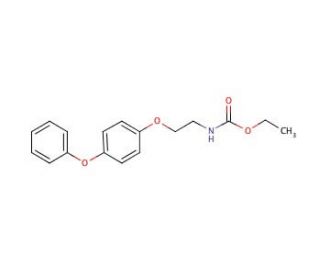

Fenoxycarb (CAS 72490-01-8)
See product citations (1)
QUICK LINKS
Fenoxycarb is an insect growth regulator (IGR) that belongs to the carbamate family. Fenoxycarb is primarily used for its pesticidal properties and finds applications in the agricultural and pest control industries. Scientifically, Fenoxycarb is valued for its ability to disrupt the growth and development of insects. It acts as a specific inhibitor of chitin synthesis, which is an essential component in the exoskeleton of insects. By inhibiting chitin synthesis, Fenoxycarb interferes with the molting process and prevents insects from reaching their mature form. This mechanism of action makes it an effective tool for controlling insect populations. Fenoxycarb is employed in agricultural settings to manage pests that affect crops. It has demonstrated efficacy against various insect pests, including Lepidoptera, which encompasses moth and butterfly larvae, as well as other insect species such as aphids and whiteflies. By targeting the chitin synthesis pathway, Fenoxycarb disrupts the normal growth and development of these pests, reducing their ability to cause damage to crops. In addition to agricultural applications, Fenoxycarb is used in public health programs to control insect vectors responsible for diseases such as malaria and dengue fever. By impeding the growth and development of mosquito larvae, Fenoxycarb aids in preventing the spread of these vector-borne diseases. Fenoxycarb′s selectivity and low toxicity to non-target organisms make it an environmentally friendly option for pest control. It has a favorable toxicological profile and is considered safe for use when following proper application guidelines. This characteristic contributes to its use in integrated pest management strategies that aim to minimize the reliance on conventional pesticides and reduce the environmental impact of pest control practices.
Fenoxycarb (CAS 72490-01-8) References
- Disturbance of adult eclosion by fenoxycarb in the silkworm, Bombyx mori. | Dedos, SG. and Fugo, H. 1999. J Insect Physiol. 45: 257-264. PMID: 12770373
- Chemistry and environmental fate of fenoxycarb. | Sullivan, JJ. 2010. Rev Environ Contam Toxicol. 202: 155-84. PMID: 19898762
- Ovicidal and larvicidal modes of action of fenoxycarb against the cat flea (Siphonaptera: Pulicidae). | Marchiondo, AA., et al. 1990. J Med Entomol. 27: 913-21. PMID: 2231627
- The effect of the juvenile hormone analog, fenoxycarb, on ecdysone receptor B1 expression in the midgut of Bombyx mori during larval-pupal metamorphosis. | Goncu, E. and Parlak, O. 2012. Folia Histochem Cytobiol. 50: 52-7. PMID: 22532136
- Photocatalysis of fenoxycarb over silver-modified zeolites. | Ahern, J., et al. 2015. Environ Sci Pollut Res Int. 22: 3186-92. PMID: 24562452
- Sublethal Effects of Fenoxycarb on the Plutella xylostella (Lepidoptera: Plutellidae). | Mahmoudvand, M. and Moharramipour, S. 2015. J Insect Sci. 15: PMID: 26136495
- Fenoxycarb exposure disrupted the reproductive success of the amphipod Gammarus fossarum with limited effects on the lipid profile. | Arambourou, H., et al. 2018. PLoS One. 13: e0196461. PMID: 29702662
- Fenoxycarb and methoxyfenozide (RH-2485) affected development and chitin synthesis through disturbing glycometabolism in Lymantria dispar larvae. | Zhang, G., et al. 2020. Pestic Biochem Physiol. 163: 64-75. PMID: 31973871
- Cascading effects caused by fenoxycarb in freshwater systems dominated by Daphnia carinata and Dolerocypris sinensis. | Lu, Y., et al. 2020. Ecotoxicol Environ Saf. 203: 111022. PMID: 32888608
- Histological investigation of the effects of fenoxycarb on neurosecretory cells in the silkworm, Bombyx mori brain. | Tanriverdi O, E. and Yelkovan, S. 2020. Invert Neurosci. 20: 20. PMID: 33090262
- Effect of a novel juvenoid fenoxycarb on the pupal-adult transformation in the blowfly, Chrysomya megacephala (Fabricius, 1794) (Diptera: Calliphoridae). | Maddheshiya, R. 2021. Parasitol Res. 120: 2351-2356. PMID: 34100111
- Anti-proliferative and apoptosis-inducing effects of juvenile hormone analogue, fenoxycarb in the Sf21cell line. | Ayisha Banu, C. and Manogem, EM. 2022. Pestic Biochem Physiol. 187: 105182. PMID: 36127044
- Fenoxycarb exposure affects antiviral immunity and HaNPV infection in the cotton bollworm, Helicoverpa armigera. | Attarianfar, M., et al. 2023. Pest Manag Sci. 79: 1078-1085. PMID: 36424349
- Effects of fenoxycarb on the secretory activity of the prothoracic glands in the fifth instar of the silkworm, Bombyx mori. | Dedos, SG. and Fugo, H. 1996. Gen Comp Endocrinol. 104: 213-24. PMID: 8930612
- Reproductive effects of fenoxycarb on sheep. | Barr, AC., et al. 1997. J Vet Diagn Invest. 9: 401-6. PMID: 9376430
Ordering Information
| Product Name | Catalog # | UNIT | Price | Qty | FAVORITES | |
Fenoxycarb, 250 mg | sc-235127 | 250 mg | $90.00 |
